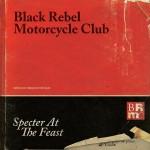
Black Rebel Motorcycle Club Specter at the Feast
(Abstract Dragon)
What springs to mind when you think of Black Rebel Motorcycle Club? I know I picture a modest, leather-clad, shades-donning stable that hold their trademark eerie, foreboding grooves in much higher regard than the dazzling spotlight that many bands ultimately aspire to fill. To intensify this image, I find myself hearing an unmistakable, advancing procession of bass-central memoirs, urged home and laced with more blues than a Dulux wall chart. With the release of Specter at the Feast, the Californian’s 7th full length LP, these preconceptions of the band's sound are there in all their grandeur, but with a provocative, sophisticated subtlety added to their established blueprint. Penetrating grooves are punctuated by melodic ballads, and the unmistakable blues-rock-nucleus is as controlled as it’s ever been. A methodical, manufactured meticulousness makes Specter at the Feast an undoubtedly intriguing installment to the BRMC catalogue.
The methodical construction is evident right from the outset of Specter at the Feast. Opening track Fire Walker crawls from a beautifully textured keyboard ensemble into a controlled, bass-heavy advance, maintaining a careful pace. It works perfectly, with the slow chug providing an ideal platform for a revolving kaleidoscope of blacks and reds to emboss itself on the back of a listeners eyelids. With the scene set, the unmistakable tones of Peter Hayes’ guitar make a cover of The Call’s Let The Day Begin sound as authentic as Fire Walker did before it. Specter at the Feast is the first LP from BRMC since the death of Robert Levon Been’s father, Michael Been, and this cover of his band’s most recognized hit acts as an early tribute to Michael. The band’s future was uncertain following of the death of a man often referred to as the 4th member of BRMC (Been often toured with the band), and the unequivocal release associated with their take on Let The Day Begin serves as a fitting tribute to a man held very close to their hearts.
Despite this, my most overriding criticism of this album is the track listing. Fire Walker and Let The Day Begin are perfectly placed, building a solid foundation for the album to move forward. However, the amelioration of Specter of the Feast is, in my opinion, obstructed by the fact that the changes of pace and more canorous ballads seem to come along in pairs. 3rd track Returning, although a fine showcase of the band's melodic capabilities, seems to hamper the progress of the album in its early stages. This is further confirmed by the fact that another softer, melodic number, Lullaby, follows immediately after. Although these are not necessarily weak tracks, I feel that a more carefully devised order of the tracks of this LP would make it easier to listen to in one given listen, and keep interest levels at their maximum.
It is definitely worth noting that Leah Shapiro’s performance throughout Specter at the Feast is excellent. Her arrival behind the kit following Baby 81 was no doubt a reinvigoration that the band needed at the time, and this was shown by the revitalization that was 2010’s Beat the Devil’s Tattoo. Her scrupulous beats border on lethargic, but are the perfect garnish for the crawling basslines and textured guitars. Her performance on Rival is a particular highlight. If you were to play only the drum track to this distorted, veneering thumper, you would be in no doubt as to what stage of the track you were at; almost Grohl-esque fills and cymbal control are more than noteworthy throughout the record, and particularly on Rival.
The heavier tracks, which although don’t depart too extravagantly from the BRMC we know and love, manage to feel like onslaughts of energy, and are particularly welcome following the slower burners. Hate the Taste, Teenage Disease, and Funny Games are prime example of this, and confirm that the concoction of Specter of the Feast was not undertaken for the sake of it. Some Kind of Ghost and Sometimes the Light are another example of ballads coming in pairs, and not fulfilling the full potential of the album, but they are once again very solid showcases of the extent of the band’s repertoire, nonetheless.
There is no doubt that Specter at the Feast is a very cohesive, controlled LP. The songwriting is as good as it’s ever been, and provides the listener with a more textured, sophisticated insight into the BRMC blueprint. Careful crawls, infectious baselines and bursts of pent-up energy are the recurring motifs of the band’s 7th LP, and for large parts it reaches a level that is at least on par with their best work. Album closer Lose Yourself encapsulates all of the above in the shape of an 8-minute saunter to the finish line. It is a beautiful track that finishes the album as strongly as it started, and a definite highlight.
With the exception of the more melodious tracks coming in pairs and slightly hindering the flow of an otherwise excellent album, Specter at the Feast is a very good effort from BRMC, and an example of the continued revitalization that started sometime around Leah Shapiro’s arrival to the band in 2008. The sound is fresher than it has been for a while, and this is all managed whilst maintaining the trademarks and hallmarks that have always been at the centre of the band’s sound. Specter at the Feast is a very good effort, and a more than welcome addition to a BRMC fan’s record collection.
25 March, 2013 - 04:41 — Carl Purvis